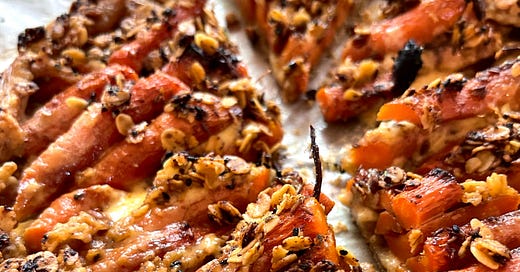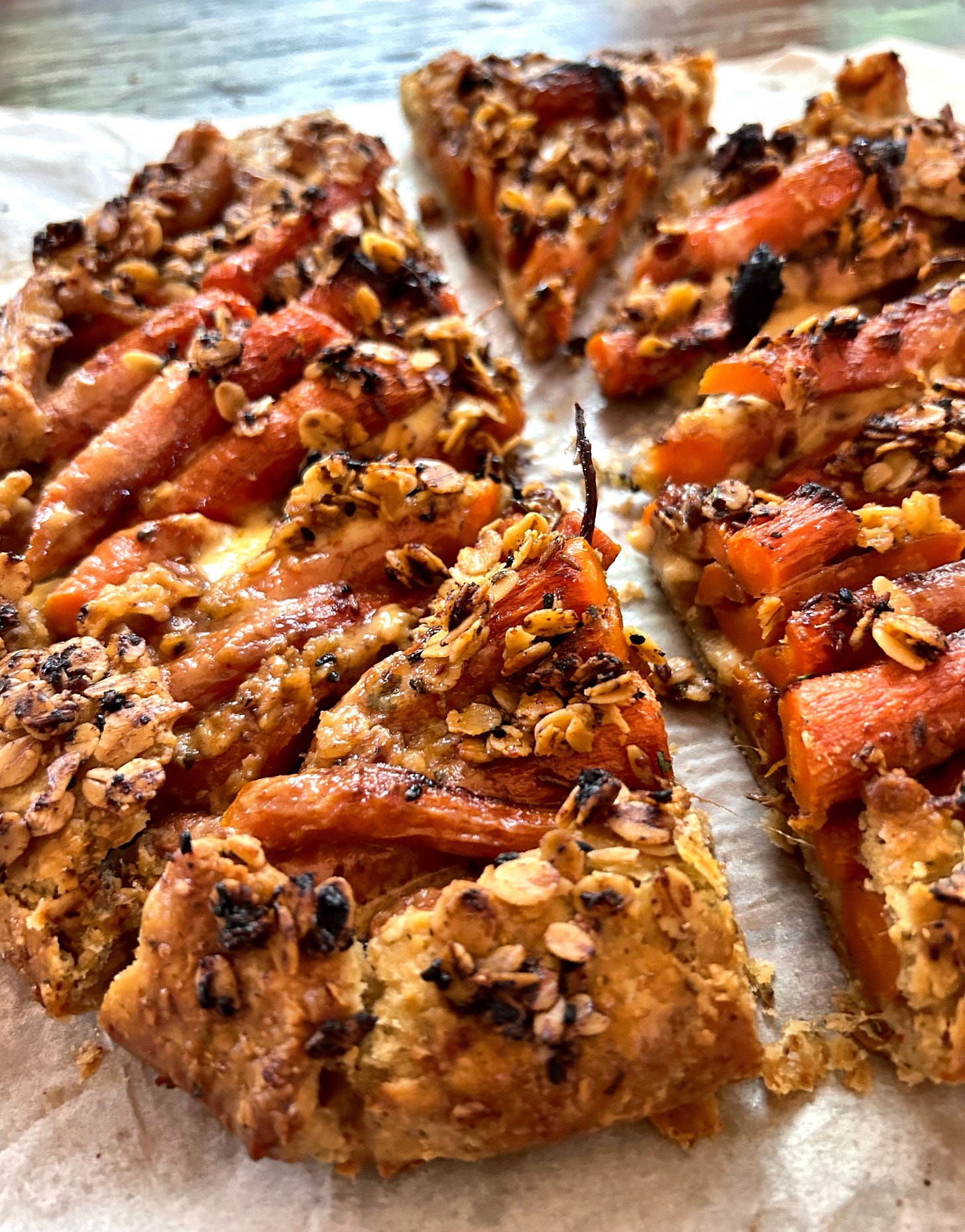a southern hemisphere Christmas + an heirloom galette
Home baked: A Year of Seasonal Baking - Summer
Home Baked: A Year of Seasonal Baking is a cookbook in weekly instalments. A subscription will ensure you don’t miss any of the stories and recipes. Please consider supporting this publication with a paid subscription. You’ll receive printer-friendly recipe cards, bonus recipes, access to Q&A, a quarterly compilation of the recipes, plus an additional Friday newsletter.
In Australia, the beginning of summer and Christmas are inexorably intertwined. The time of the year when artificial deadlines loom - work, house projects - a list of tasks that must be completed before Christmas and the holidays. The shops are ridiculously busy, everyone finally taking notice of the Christmas paraphernalia that has adorned the shelves since August. The countdown to the school holidays is on.
It could be argued that the wind-down to Christmas begins on the first Tuesday in November, Melbourne Cup day. While an official public holiday for the annual horse race is only sanctioned in Victoria, it is, for most people in formal work, a day of little productivity. Office sweepstakes, long lunches and, of course, watching the race. It’s not as if everything grinds to a halt after Melbourne Cup Day, but rather that the collective mood changes. The weather is warming up, the end of the year is in sight, and everyone seems a little lighter.
Residing in the southern hemisphere, you get used to living out of sync with the majority of the world’s population. Major sporting events are invariably held in the middle of the night, and my social media feed is full of lush tomatoes when there is frost on the ground here. But the difference is most obvious at Christmas. We emigrated to Australia from England when my mother was 30. She grew up in Germany and England, and even after being in Australia for almost 50 years, far longer than she has lived anywhere else, still thinks that a summer Christmas doesn’t feel like Christmas. I had the best of both worlds. Just old enough to have vague memories of a winter Christmas - the scent of a real pine tree, the possibility of snow and cold weather food, but young enough to embrace a new Christmas norm of sweltering humidity, mangoes and stone fruit.
We arrived in Australia less than a month before Christmas, and only a few days before Christmas Day moved from the Canberra Hotel in the heart of Brisbane to a two-bedroom flat overlooking a park in Yeronga, a suburb that sounded exotic and so very ‘Australian’. The flat was a fully furnished one in a small block with five other flats, colloquially known as a six-pack. When we arrived in Brisbane, we were taken under the wing of the bank manager of a local ANZ Bank, back when bank managers were seen as pillars of society and prided themselves on their personal relationships with potential mortgage holders. He and his wife lent us a few household items to get us through until ours eventually arrived after a long trip at sea. I only remember the pillows, which were hard, uncomfortable slabs there was no getting used to.

Despite just moving in, an effort was made with Christmas, probably to appease my sister and I, and the search for a Christmas tree began. The real trees sold as a fundraising venture by the local scouts were leggy and shapeless and deemed unsuitable by my Mother. Similarly, the fake trees were also considered a poor substitute; if our tree were to be artificial, it would not pretend it was real. This was how we ended up with a sparkly silver tinsel tree, under which the few wrapped presents we had carried in our luggage were placed.
Perhaps unsurprisingly, we were invited to the bank manager’s house for Christmas lunch, a much more laid-back affair than we were used to. It was an outside-in-the-garden occasion and where I first ate watermelon. I can’t recall what else we ate; a traditional English Christmas lunch would probably have graced the table - turkey, roast vegetables, gravy and Christmas pudding, perhaps a cold leg of ham, trifle and summer fruit, the only concessions to the heat. The oven would have been on for hours, contributing to the temperature and anyone lucky enough not to be in charge of the food decamping to the garden and the esky of cold drinks. Collectively, it's taken a while to shake those traditions, but thankfully, seafood, salad, pavlova, summer fruits and an ever-increasing menu of suitable dishes are now more likely to be served.
Recently, I’ve wondered if I enjoy the lead-up to Christmas more than Christmas itself. I like the anticipation, the air of excitement that hovers nearly everywhere, the slightly frantic pace that is noticeable in the supermarket, the endless playing of Christmas carols (I remember the words of the most obscure carols - a legacy of school learning and family attendance at whatever local carols by candlelight happen to be on), advent calendars, decorating the tree and the meal planning.
With a combination of meat eaters and vegetarians, Christmas lunch is often an eclectic mix of dishes that vary from one year to the next. It takes a bit more imagination to create a vegetarian dish that has the same impact as a huge roast turkey or leg of ham. Among the collection of salads, the vegetarian showpiece is often a pie or tart of some description. This carrot galette would be an excellent candidate.
Part of the appeal of a galette is its rustic appearance, which, if you’re nervous about your pastry skills, allows you to plate your offerings without any misplaced need to apologise for its looks. I always make my pastry in the food processor. The hands-off approach keeps the pastry cool, and the blade ensures it isn’t overworked. There are a few steps to baking this tart, but none of them difficult. It looks extra special if you are able to find multi-coloured carrots, but isn’t worth traipsing everywhere to find them!
Carrot Galette
Serves 6-8
Pastry
50 g rolled oats
80 g plain flour
50 g spelt flour
1 tablespoon fresh oregano leaves
100 g salted cold butter, cut into cubes
40 ml cold water
Filling
500 g baby carrots, scrubbed clean
2 tablespoons olive oil
2 teaspoons cumin seeds
1 teaspoon Aleppo chilli
2 teaspoons runny honey
1 tablespoon pomegranate molasses
½ teaspoon salt
several grinds of black pepper
150 g crème frâiche
1 egg
Oat topping
30 g rolled oats (not quick oats)
½ teaspoon nigella seeds
½ teaspoon fresh oregano, finely chopped
½ teaspoon Aleppo pepper
generous pinch of salt
several grinds of black pepper
1 teaspoon pomegranate molasses
1 tablespoon olive oil
To make the pastry, put the oats into a dry frying pan and toast over a medium heat. Take care to stir them regularly so that they don’t catch. Toast for 8-10 minutes or until the oats turn golden and smell nutty. Remove from the heat and leave to cool completely before making the pastry.
Tip the cooled oats into the food processor along with the flours, oregano and butter. Whizz until the mixture looks crumbly but still has some texture. Pour in the water and mix until the pastry comes together.
Tip onto the kitchen bench and knead a couple of times before patting the pastry into a disc, wrapping it in plastic wrap and refrigerating for 30 minutes.
Preheat the oven to 180°C
Remove the green tops from the carrots.* I like to leave just a little of the green stalks on the top of the carrot to add to the rustic look. Larger carrots should be cut in half lengthways. Place the carrots into a baking tray and toss with the remaining ingredients, except the crème frâiche. Place in the oven and bake for 30 minutes or until the carrots can be easily pierced with the tip of a sharp knife. Remove from the oven and allow to cool.
While the carrots are roasting, make the oat topping by mixing together all of the ingredients in a small bowl.
Increase the oven temperature to 200°C.
Take the pastry from the fridge. Roll it out on a piece of baking paper until it has a diameter of about 30 cm. Place the baking paper with the pastry onto a baking tray. Spread the crème frâiche on the surface of the pastry, leaving a border of about 2 cm around the outside. Pile the carrots on top of the crème frâiche and then fold the edges of the pastry over the filling. Crack the egg into a small bowl, add a splash of water and mix together. Brush the egg on the pastry. Sprinkle the oat mixture over the top of the galette and bake for 30-35 minutes or until the pastry is golden. The crème frâiche might bubble up a bit between the carrots but will calm down once it cools. Serve warm or at room temperature. The galette will keep for a couple of days in an airtight container in the fridge and can be reheated.
* For paid subscribers, there is a recipe for carrot top chimichurri below
Christmas is only a few days away, and I’d like to wish you all a merry Christmas. The lead-up to Christmas is often fraught, so I hope you have a chance to relax, spend some time with family, friends and loved ones, and recharge the batteries a little. I’ll be taking a break next week but will return with the regular schedule in the new year.
Next time: easing into a lazy January + spinach & herb savoury cheesecake
Join me, avid baker and occasional rule breaker, as I share my love of baking, adapting what we bake to suit the seasons. Your support for this project is greatly appreciated. Each weekly post is available to all subscribers.
For paid subscribers, a printer-friendly recipe card for the carrot galette, along with a carrot top chimichurri recipe, is below. As a paid subscriber, you receive this bonus material as well as an additional newsletter each Friday.
Keep reading with a 7-day free trial
Subscribe to Apples & Elderflower to keep reading this post and get 7 days of free access to the full post archives.







